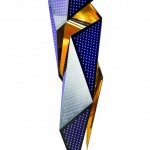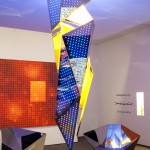eL Masterpiece – Daniel Libeskind – Austria
Design: Daniel Libeskind Studio
Structure: outside: Stainless steel, high-gloss polished Material, inside: Stainless steel, 23 carat leaf gold-plated
Client: Zumbtobel
Height: 8.86 Feet.
Width: 34 inches / 29 inches.
Light Source, outside: 1,680 RGB LED modules.
Light Source, inside: 3 Light Engine LED, 3,000 K.
Controls: Microcontroller.
Power Consumption: 430 W.
Status: Completed
Completion Date: 2011
Project Brief
Daniel Libeskind’s eL Masterpiece is roughly nine feet tall and two-and-a-half feet wide. It weighs 350 pounds. A luminous, sharp-edged, cascading shape, the chandelier has a highly-polished stainless steel exterior and a stainless-and-23-carat-gold-plated-leaf interior. Created in collaboration with Austrian lighting company Zumtobel, the limited-edition eL Masterpiece chandelier is distinguished by both its striking design and the sophisticated technology that underlies it.
The light emitted by eL mimics and reproduces the cosmic light that fills the Universe. To achieve this, Dr. Noam I Libeskind, Daniel Libeskind’s son and an astrophysicist at the Leibniz Institute for Astrophysics in Potsdam, used eL’s LEDs to represent the Big Bang and the Universe’s expansion. The dynamic lighting illustrates the evolution of mass and structure in the Universe: each LED represents a small volume of outer space.
The idea is based on the theory that the Universe is around 14 billion years old and that its building blocks – galaxies like the Milky Way – grew larger as the Universe aged. As they grew larger, the light their stars emitted changed, visible as the eL emits different colours. State of the art simulations run on massive super-computers were used to compress a billion years into one second so that the eL’s time loop plays back the history of the cosmos in 14 seconds and, in doing so, tells the story of how light came into being.
- eL Masterpiece Lamp – Daniel Libeskind – Austria
- eL Masterpiece Lamp – Daniel Libeskind – Austria
- eL Masterpiece Lamp – Daniel Libeskind – Austria
- eL Masterpiece Lamp – Daniel Libeskind – Austria
- eL Masterpiece Lamp – Daniel Libeskind – Austria
- eL Masterpiece Lamp – Daniel Libeskind – Austria
- eL Masterpiece Lamp – Daniel Libeskind – Austria
- eL Masterpiece Lamp – Daniel Libeskind – Austria
- eL Masterpiece Lamp – Daniel Libeskind – Austria
- eL Masterpiece Lamp – Daniel Libeskind – Austria
















No Comments